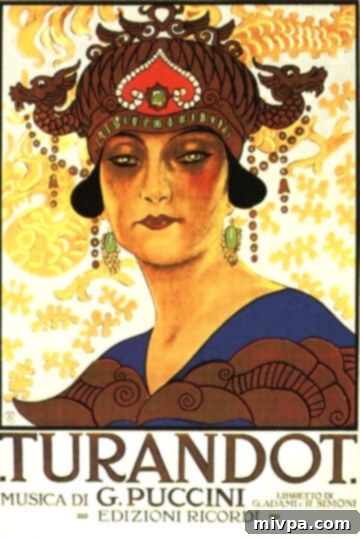Discovering Authentic Hungarian Cuisine: A Goulash Journey at Turandot in Palermo, Buenos Aires
There’s a unique joy in traveling the world through its diverse culinary landscapes. Exploring different cuisines offers a delicious window into cultures, traditions, and the shared human experience around the table. My latest gastronomic adventure led me to the heart of Hungary, right here in Buenos Aires.
Last Friday evening, my friend Susana and I found ourselves with a rare window of free time, perfect for a long-overdue catch-up. As dinner approached, I suggested we try something different. Knowing my penchant for variety, I wanted to introduce Susana to a cozy and charming Hungarian restaurant called Turandot, nestled at Fitz Roy 1747 in the chic Palermo neighborhood. It was a place I had visited before and longed to revisit, eager to delve deeper into Hungarian flavors.
The Intriguing Name: Unraveling “Turandot”
When I first encountered the name “Turandot,” my initial thought was that it must have some fascinating Hungarian origin, perhaps a traditional folk tale or a historical figure. However, a quick search on the internet revealed a much broader and more dramatic story. The name predominantly brings up a famous opera by Giacomo Puccini, an iconic work in three acts with an Italian libretto by Giuseppe Adami and Renato Simoni.
The narrative of Puccini’s opera, as detailed on Wikipedia, is rooted in earlier literary works. While Puccini’s interest was sparked by Friedrich Schiller’s adaptation of the play, his opera draws most directly from Carlo Gozzi’s earlier text, also titled Turandot. This captivating tale is set in ancient China and revolves around Prince Calàf, who falls deeply in love with the beautiful yet cold Princess Turandot. To win her hand, any suitor must successfully answer three riddles; failure means certain death. Calàf bravely attempts and passes this perilous test. Yet, Princess Turandot hesitates, unwilling to marry him. In a bold move, Calàf offers her an escape: he agrees to die if she can discover his true name before dawn.

The exact reason for this Hungarian restaurant bearing the name “Turandot” remains a delightful mystery to me. One plausible theory connects it to Gyöngyi Lukács, a celebrated soloist of the Hungarian State Opera House. Lukács has graced many of the world’s leading opera stages, notably performing the demanding role of Princess Turandot. It’s quite possible that the restaurant was named in homage to her extraordinary talent and contributions to Hungarian and international opera. If anyone possesses further insights into the restaurant’s naming, I would be absolutely thrilled to learn more!

Goulash: The Heartbeat of Hungarian Cuisine
Returning our focus to the delectable world of food, my experience with Hungarian cuisine, beyond the iconic Goulash, has been limited. Therefore, today’s exploration will delve primarily into this rich, flavorful stew that has captivated palates far beyond its Central European origins. Goulash is more than just a dish; it’s a symbol of Hungarian culinary heritage, a hearty meal steeped in history and tradition.
What Exactly is Goulash?
At its core, Goulash (Hungarian: gulyás) is a robust and comforting soup or stew, typically featuring tender pieces of meat, often beef, simmered with various vegetables—most notably potatoes—and generously seasoned with paprika and an array of other aromatic spices. While it undeniably originated in Hungary, its comforting warmth and distinctive flavor have made it a beloved staple across a wide range of countries. It’s a popular meal in Austria, Bosnia and Herzegovina, Croatia, the Czech Republic, Germany, Liechtenstein, Lithuania, the Netherlands, Poland, Romania, Russia, Scandinavia, Serbia, Montenegro, Slovakia, Slovenia, Ukraine, and even in certain regions of Italy. Each country, and even each family, often has its own cherished variation, adding local twists to this universally adored dish.
The Humble Origins of Goulash
The story of Goulash is as rich and flavorful as the dish itself, tracing back to the Hungarian plains. According to historical accounts, the word “Goulash” is derived from the Hungarian word gulyás. The root word, gulya, translates to ‘herd of cattle’ in Hungarian, while gulyás originally meant ‘herdsman.’ Over time, the meaning of gulyás evolved to encompass gulyáshús, or ‘goulash meat’ – referring specifically to a meat dish prepared by these very herdsmen.
From the Middle Ages right through to the 19th century, the vast and expansive Puszta, the traditional Hungarian grassland, was home to immense herds of cattle. These herds, numbering in the tens of thousands, were driven across long distances to reach Europe’s largest cattle markets in places like Moravia, Vienna, Nuremberg, and Venice. During these arduous journeys, the resourceful herdsmen would ensure that a “sickly” animal was, by necessity, slaughtered along the way. The meat from this animal would then be transformed into a magnificent gulyáshús, providing sustenance and warmth for the herders. This tradition laid the foundation for the goulash we know and love today, a testament to its humble, hearty origins as a frontier meal.

Exploring Hungarian Goulash Variations
Given Goulash’s deep roots in Hungary, it’s fascinating to explore some of the distinct types of Goulash found within this Central European nation. In traditional Hungarian cuisine, dishes like gulyásleves (literally “goulash soup”), bográcsgulyás (goulash cooked in a cauldron), pörkölt, and paprikás are all robust, thick stews originally prepared by cattle herders and stockmen. These dishes, while sharing a common heritage, each possess unique characteristics. Optional ingredients like garlic, fresh tomatoes, caraway seeds, vibrant bell peppers, and a splash of wine can be added to enhance their complex flavors. While some variations are undeniably stews, others are prepared with a thinner consistency, blurring the lines into hearty soups. A key distinction in Hungarian stew-making is that, with the exception of paprikás, these traditional stews typically do not rely on flour or a roux for thickening, instead achieving their rich consistency through the natural breakdown of meat and vegetables.
The beauty of Hungarian goulash lies in its versatility. There are numerous variations, each differing in terms of its primary ingredients or the side dishes it’s served with. Goulash can be prepared from various meats, including beef, veal, pork, or lamb. Typical cuts, such as the shank, shin, or shoulder, are favored because they are rich in collagen. This tough, well-exercised muscle tissue is crucial for goulash, as the collagen slowly breaks down into gelatin during the prolonged cooking process, imparting a natural thickness and silky smoothness to the stew.
The preparation typically begins by cutting the chosen meat into substantial chunks, seasoning them with salt, and then browning them alongside finely sliced onions in a pot with a generous amount of oil or lard. Once the meat is nicely seared and the onions are caramelized, the star ingredient – paprika – is added, lending its vibrant color and characteristic flavor. This is followed by water or stock, and then the goulash is left to simmer gently, allowing the flavors to meld and deepen over hours. As it cooks, additional ingredients might be introduced: crushed garlic, whole or ground caraway seeds, and a selection of soup vegetables such as carrots, parsnips, green or bell peppers, celery, and a small, ripe tomato. Other herbs and spices, including a touch of chili pepper for heat, a bay leaf for depth, or a sprig of thyme for aroma, can further customize the flavor profile. Diced potatoes are often added, not just for substance but also because their starch gradually thickens and smooths the goulash as they cook. Towards the end, a small amount of white wine or wine vinegar can be stirred in to brighten and round out the overall taste. Traditionally, goulash is often served with small egg noodles known as csipetke (also recognized as spätzle). The name Csipetke itself is quite descriptive, deriving from the Hungarian word csip, meaning ‘pinch,’ referring to the small, fingernail-sized bits of dough that are pinched off and added directly to the boiling soup.
My Return to Turandot: An Evening of Hungarian Delights
It was my second visit to Turandot, the delightful Hungarian restaurant in Palermo, Buenos Aires, and I had been eagerly anticipating this return. My first experience with Juan had been so thoroughly enjoyable that the memory lingered, fueling my desire to share its warmth and flavors with Susana.
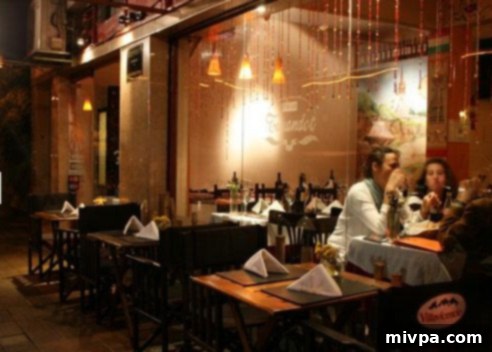
Stepping inside Turandot, we were immediately enveloped in an inviting atmosphere. The restaurant boasts a charming interior, decorated in warm, earthy colors that create a sense of comfort and intimacy. Adorning the walls were tasteful artworks, including a captivating painting of Budapest, the vibrant Hungarian capital, which subtly reinforced the restaurant’s authentic cultural theme. The lighting was soft, casting a gentle glow that enhanced the cozy ambiance, making it an ideal setting for a relaxed and flavorful meal. Every detail, from the comfortable seating to the friendly, attentive service, contributed to a truly pleasant dining experience. It felt like a small piece of Hungary transported to the heart of Palermo.
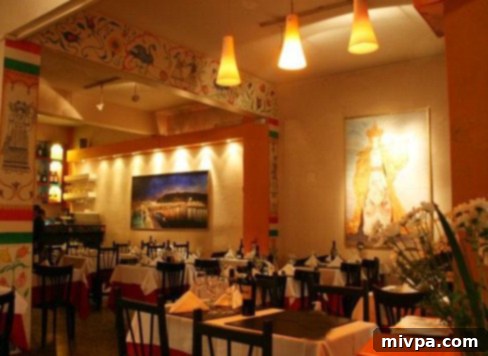
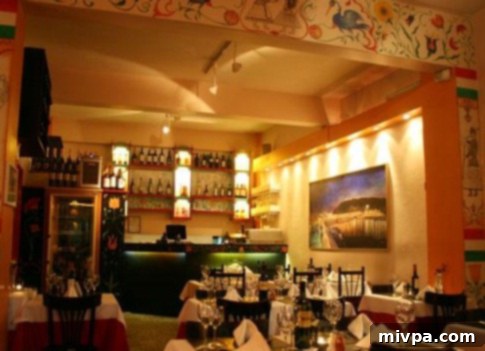
The Culinary Star: Mutton Gulyás (Birkagulyás)
The undisputed highlight of our meal was the exquisite Mutton Gulyás, or Birkagulyás, as it is known in Hungarian. This dish is a quintessential representation of Hungarian comfort food: a classic, rich stew featuring succulent pieces of mutton, potatoes, ripe tomatoes, and vibrant green bell peppers, all bathed in a luxurious red wine sauce. The sauce itself was masterfully flavored with aromatic caraway seeds and, of course, a generous hand of paprika, creating a truly unforgettable flavor profile.
Prepared with small, tender chunks of mutton, the stew is allowed to slowly stew and simmer for an extended period, a testament to the patient art of traditional Hungarian cooking. This long, gentle cooking process ensures that the meat becomes incredibly tender, almost melting in the mouth. The flavors are further intensified by the depth of red wine and a carefully balanced blend of spices, resulting in an incredibly mouthwatering and utterly victorious dish. It was served alongside spätzle, those delightful soft egg noodles that are a beloved staple in the cuisines of southern Germany, Austria, Switzerland, Hungary, Alsace, and South Tyrol.
If you’ve never had the pleasure of trying spätzle, imagine a miniature, more delicate version of gnocchi. Gnocchi, a type of thick, soft dumpling, can be made from various ingredients like semolina, wheat flour, potato, or breadcrumbs, often enriched with egg and cheese. To be completely honest, gnocchi has always been my least favorite pasta due to its sometimes overwhelming carb-heavy density. However, I developed a surprisingly strong affinity for spätzle. Its small, irregular shape and light, chewy texture provide the perfect counterpoint to the robust and intensely rich flavors of the mutton goulash. The portion of spätzle was just the right amount of carbohydrate to complement the stew without overpowering it, adding a textural and flavorful dimension that elevated the entire dish.
This Mutton Gulyás is the epitome of comfort food, ideally suited for a cool, perhaps rainy, evening. It’s the kind of dish that not only fills your stomach but also thoroughly warms your heart. Every spoonful offers a sense of profound contentment, leaving you feeling happy, deeply nourished, and wonderfully cared for. It’s a culinary embrace in a bowl.
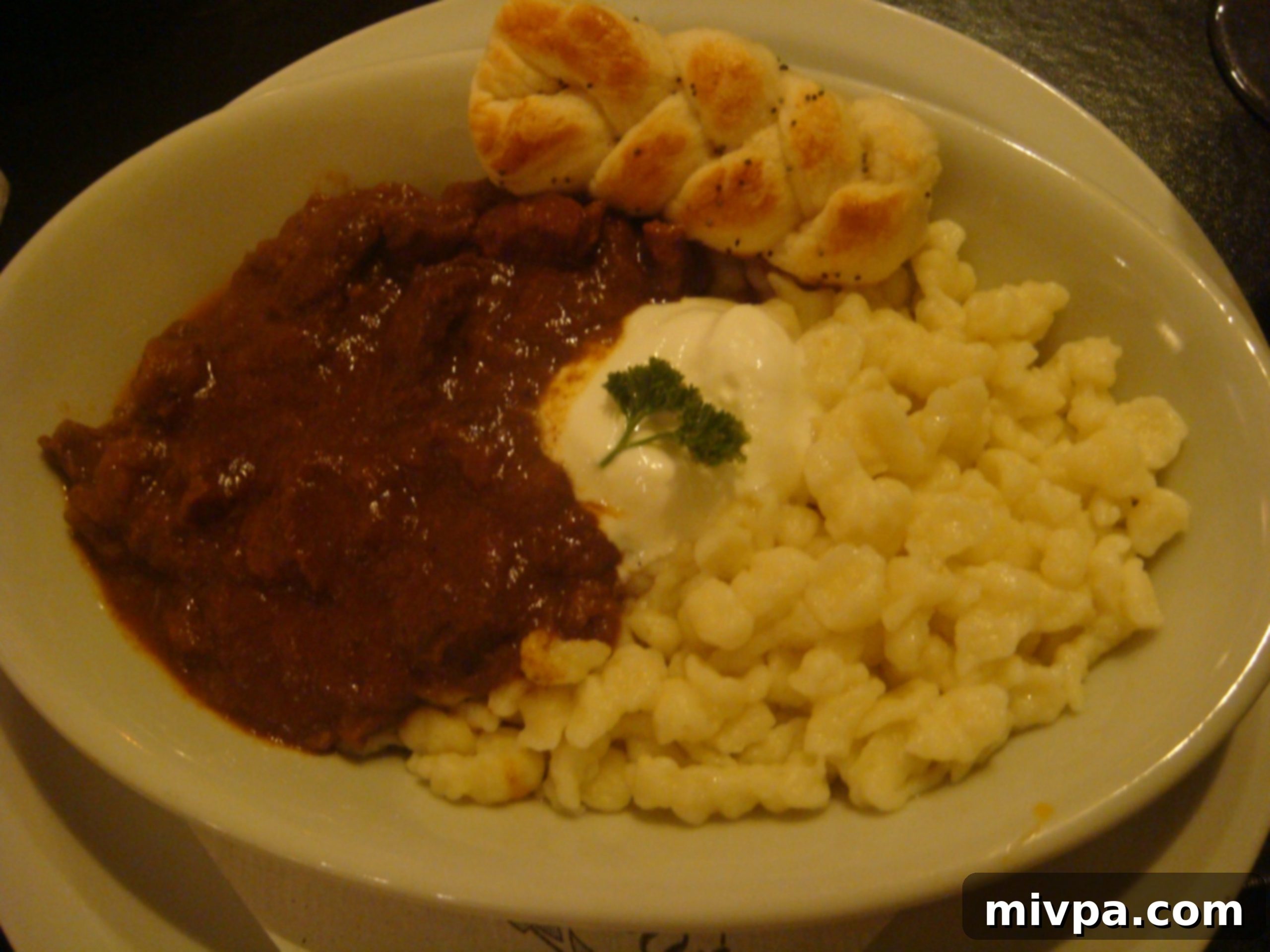
As is often the case when indulging in such a satisfying main course, we found ourselves too delightfully stuffed to even contemplate ordering dessert. Instead, we settled for the perfect accompaniment: a generous glass of the house red Malbec wine each. Its smooth, rich notes paired with the deep flavors of the goulash in the most enchanting way, providing a truly harmonious conclusion to our meal.
Considering the quality of the food, the warm and inviting Hungarian ambiance, and the overall delightful experience, the price point was remarkably reasonable. At approximately 100 pesos per person, including tips (around USD 20 at the time), it offered incredible value. I would unequivocally rate Turandot a solid 9/10 for its authentic flavors and charming atmosphere. It’s a place that truly delivers on its promise of a delightful Hungarian culinary journey.
Without a doubt, I am already planning my return. Very, very soon!
